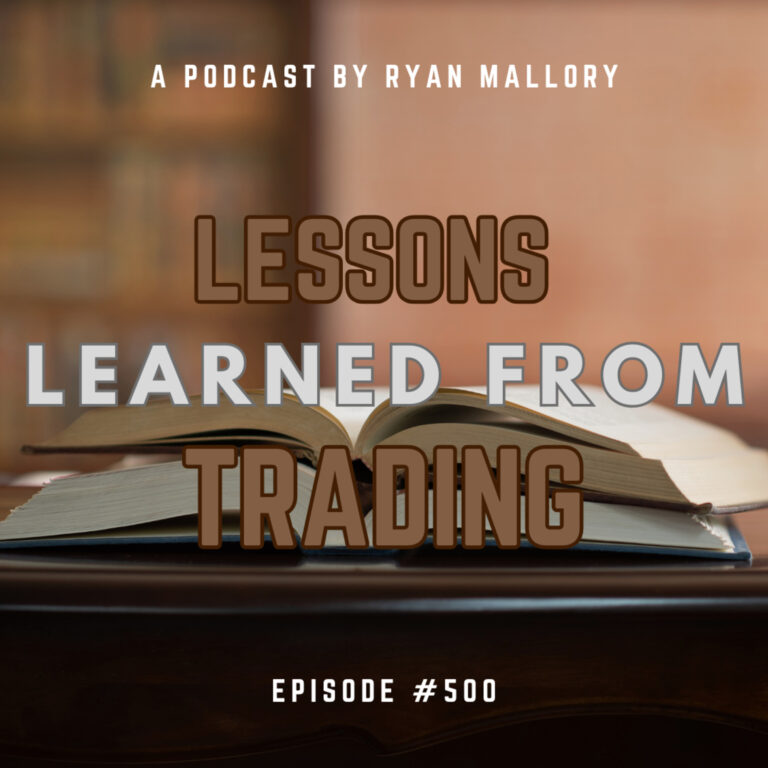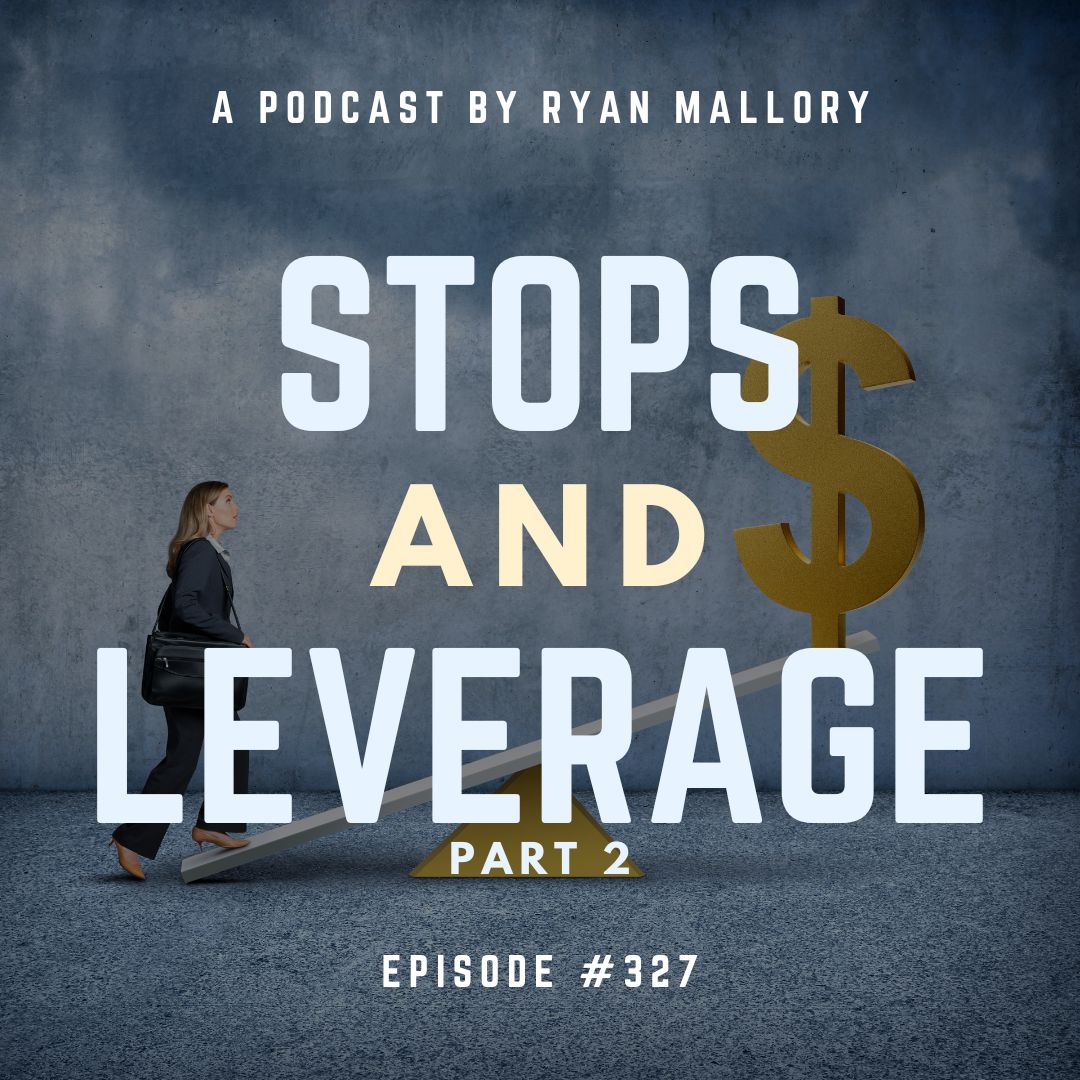Episode Overview
Ryan picks up where he left off on last episode talking about inverse ETFs and why in most cases it is better to simply use 1:1 leverage than 2:1 or 3:1. Also, more about stop-loss placement and where he raises the stop to, after a swing trade becomes profitable.
Available on: Apple Podcasts | Spotify | Amazon | YouTube
Episode Highlights & Timestamps
- [0:07] Revisiting Barry’s Email
Ryan kicks off Part 2 by rereading Barry’s full email and preparing to answer the second half of his questions. - [2:05] Raising Stop Losses After Market Close
Ryan explains how and when he adjusts stop losses, usually after the market closes but sometimes during large gap-ups in volatile conditions. - [3:56] Managing Big Gap Ups
Walks through an example using a $100 stock to illustrate how to scale out and structure stop-loss tiers after a gap-up. - [6:35] Support Levels and Candle Pullbacks
Answers Barry’s question on whether to wait for one or two pullbacks and how Ryan sets stop losses based on where he no longer wants to be in the trade. - [8:35] Trading Commodities and Leveraged ETFs
Discusses his experience with commodities, indices, and leveraged ETFs and why he often prefers 1:1 exposure for better risk management.
Key Takeaways from This Episode:
- Stop losses should adjust with context: Ryan usually raises stop losses after the close but will react intraday to large gap-ups or volatile action.
- Scale out to reduce risk while letting trades run: Taking a third off after a gap-up and tiering stop losses helps manage both profits and risk.
- Support levels define exit points: If support is broken, it’s time to exit. That’s more important than the number of pullbacks or candle types.
- Avoid overusing leverage: Ryan prefers 1:1 ETFs for less volatility and more manageable stops, rarely using 2:1 or 3:1 products.
- ETFs help spread risk: ETFs like QQQ or IBB are less volatile than single stocks, offering better control over portfolio drawdowns.
Resources & Links Mentioned:
- Swing Trading the Stock Market – Daily market analysis, trade setups, and insights by Ryan Mallory.
- Join the SharePlanner Trading Block – Get real-time trade alerts and community support.

Take the Next Step:
✅ Stay Connected: Subscribe to Ryan’s newsletter to get free access to Ryan’s Swing Trading Resource Library, along with receiving actionable swing trading strategies and risk management tips delivered straight to your inbox.
📈 Level Up Your Trading: Ready for structured training? Enroll in Ryan’s Swing Trading Mastery Course, The Self-Made Trader, and get the complete trading course, from the foundational elements of trading to advanced setups and profitable strategies.
📲 Join the Trading Community: Sign up for SharePlanner’s Trading Block to become part of Ryan’s swing-trading community, which includes all of Ryan’s real-time swing trades and live market analysis.
Full Episode Transcript
Click here to read the full transcript
0:07
Hey, I’m Ryan Mallory and this is my swing trading the stock market podcast. I’m here to teach you how to trade in a complex ever-changing, world of Finance, learn what it means to trade, profitably and consistently managing risk, avoiding the pitfalls of trading. And most importantly, to let those winners run wild, you can succeed at the stock market and I’m ready to show you how, hey, everybody, this is Ryan Mallory with swing trading the stock market part 2.
0:35
Ooh of stops and leverage here. I’m going to go back and read the email that we started. This podcast is two part series podcast last week and so I’m going to start from the beginning and then we’re going to pick up about Midway through answering his questions again. So he writes, hey Ryan, remember to this guy, we gave him the name, Barry, because that was the Aussie name that I gave him last time, and this is actually his second email.
1:00
So he writes, great emails. Great questions. So I don’t mind giving a multiple podcast, if he Do that so very right. Hey Ryan really enjoying the trading at the moment making steady gains and I continue to listen to your podcast. Question 1. I know that you usually allocate the same amount of capital to each trade and take profits along the way.
1:18
However do you add to your positions as you go? I recently added more Capital to my brokerage account. So I’m trading with around $800, I have about a hundred dollars allocated to each position. Second part of the question. I know that you keep risk as tight as possible to improve your risk.
1:34
Reward ratio. However, Or do you ever use leverage on a stock trade if the risk is low? Question 2? If there’s a turn in the market, for example, a decline in stock value across the markets like a big red day. Do you close your positions or do you write it out to see if it hits your stop-loss?
1:49
Second part of this question is, do you pay much attention to the intraday price action of a stock and do you? Wait till the end of the day to take partial profits? I’m generally taking partial profits at around three percent gains in my position. Okay? So those were the questions from the last episode, the new questions for this episode.
2:05
Going to be one also, when raising your stop losses, you wait till after the training session is closed in with a key support level of you, wait for a pullback on the chart where the candles pull back twice for example, on a 30-minute chart do you wait for one pullback on a bullish Hammer, candle or wait for to Candle pullbacks to the same level question 3 you ever trade Commodities and indices if you can manage the risk.
2:27
Thanks again, Ryan. Cheers, Barry. Alright, good questions, I’ve got some good answers for them. I don’t think they’re, it’s going to be too complex, starting with. Raising my stop losses. After the trading session is closed more times than not. I’m usually raising my stop losses after the market closes. That doesn’t mean that I won’t do it during the trading session.
2:44
When that happens, it’s usually because I’m already up a lot in the stock, makes another big move and so I want to start pushing that stop off a little bit more especially if it’s a pretty volatile Market environment. I’ll do that especially with big gaps higher at the open.
3:00
Let’s say I have a strong Gap, higher say I get okay back to the hundred dollar, Share stock on an imaginary stock symbol x y z at $100. I get in at $100, let’s say I spend a couple of days between 100 101 dollars, stock hasn’t really done too much, then it gets it upgrade the next day and now it’s trading 7 or 8% higher.
3:19
Am I going to wait till the end of the day to raise that stop-loss know? Probably what I’m going to do is take some profits off the table probably like a third and then I’m going to raise that stop-loss some. So usually what I’ll do is like wait the first 30 minutes of trading, let it put in a new low from where it opened up at and times.
3:35
It may not be that much of a low, it may just like take off and continue to add on to those gains a so it makes adding a stop loss even easier. So, what I’ll often times do is add my stop loss to the lows of the day to wear. If it starts to fill that Gap.
3:56
I’m not risking all the prophets that I just made on that trade from an overnight Gap higher, because that does often happen especially like around earnings. Not that I trade around earnings because I don’t, but, you’ll see stocks have some massive Fades after earnings announcements.
4:11
And so, a lot of people when they see Some positive news. It gets them all excited. And they say to themselves man, this thing is going to go so much higher is already up 7% at the open. Maybe I’ll go up 15 or 20 percent on the day and sometimes that may happen.
4:37
And with it it’s going to take the value or the profits that you had and stock XYZ and just diminish it all day long to wear your. It’s like the slow steady drip lower to where your left at the end of the day saying, man, I just wish I would have taken some profits at that time where put a stop loss just below golos of that Gap higher from that morning and if you had, you would have been able to get out of that position with a decent gain.
4:59
So to fold you, take some profits right out at the open in case your stock is that going to continue pushing hi. Throughout the day. And if it doesn’t, you have a stop loss at the lows of the day to wear, if it takes out those lows, you’re getting out of the trade anyway.
5:20
If it chose to do. So if it continues to rip higher, then that’s great, you can continue to move your stop loss, higher as well. And then the other thing that you can do is leave in this is like, having essentially multiple stop losses here, but you’re in stock XYZ at $100 a gaps. Higher.
5:35
Okay, you take a third off the table and then after the first 30 minutes or so, when you see some price action playing out, you get word, the lows of the day are currently put a stop loss below, the lows of the day for another third of your position.
5:51
So, you have a third at the open that you Tokyo of a third at the lows of the day, following the Gap higher. And then you have a third at your original price, which is also, you know, a good way to manage risk as well, because then you’re getting two thirds of your position out.
6:11
That’s also moving up your stop-loss. Moving up, your stop loss to where you got in at or you can leave it where your original stop losses. But I would think that that would be enough reason to move it up to at least Break Even to see by giving it enough room to decide, okay?
6:35
He says it with a key support level. Do you wait for a pullback on the chart where the candles pull back? Twice, for example, on a 30-minute chart? You wait for one pull back on a bullish Hammer, candle or wait for to Candle pullbacks to the same level.
6:55
Stop losses is essentially this you want to be placing it in an area where if that price level is breached you know that you don’t want to be in that trade anymore and all. The times that coincides with support on the charts. In fact, it always is whether it’s trend line support or price level support or some kind of like pattern support when those levels are breached, that’s where I don’t want to be in that trade anymore.
7:17
So you take, for instance, a breakout you, let’s say this x stock, XYZ breaks out at a hundred and goes to 105 and then pulls back to 100 and bounces again. Well, that would be just one test. It could be a hammer candle, it could be any kind of candle but it tests it and it bounces It and then when it starts to bounce, that’s when I want to get in and I want to put my stop loss below that level where it bounced at.
7:42
And so that could be just a v-shaped bounce where it hits it and goes right back up again. Also want to take a moment to remind you guys check out swingtradingthestockmarket.com, that is my Patron service, where you get all my stock market research each and every day, that’s going to include updates on the overall stock market updates on all of the fangs, stocks plus, Microsoft, and Vidya and Tesla.
8:03
And it’s going to Give you my weekly, bullish and bearish master watch list, plus each day. I’m going to be telling you the daily wash lists, the stocks that I’m following and some really cool videos as well on different trade ideas that I come across throughout the course of a trading day.
8:20
So check that out. swingtradingthestockmarket.com, it’s really awesome.
8:35
But I am in it because the markets really not doing anything. But nonetheless, I do trade Commodities and indices. I don’t do a lot of Commodities. I think it’s been a minute since I last traded oil. That would be like stock symbol Uso. That’s it, ETF actually but there’s also gold.
8:52
There’s also silver. I don’t mind doing those. There’s bonds TLT, I don’t mind doing that. One of the things that I’m very cautious of is using the leverage DTS. Now, I’ve done plenty of them in the past, I think, if you look at my progression with ETS over the As I’ve gone from using a lot of 32 ones to to ones.
9:08
And now I use a lot of just 12 ones. Now, on the trading Blox, my sees me perhaps, get into a particular trade. If they decide, they want to follow me in on that trade as well. Sometimes, they’ll do a two to one or a three, two one. You know, for me, I’m always just doing one to one doesn’t mean that I won’t consider doing a two to one and the future, but it has to be really the right circumstance for me to jump into a 2 to 1.
9:29
Leverage DTF more times than not. I’m going to do a one to one in the main reasons for that. And I’ve actually done a whole podcast. Episode on that line of thinking is that one, you get to stay in the trade a little bit longer to where you don’t have to be right right away.
9:45
Whereas, with the two ones and the three, two, one ETS, the movements are so crazy. You have to have a much tighter stop loss and oftentimes, that results in a less quality stop loss than if you are using a one-to-one because a 4% stop loss on sh or on spy is going to be much different than a 4% stop loss on SSO or SDS which is the 221 equivalent.
10:05
Of the S&P 500 or spy. And so with that line of thinking, my stop loss on Spire sh B, 4 percent. Then it would have to be almost 8% of a loss that I would have to take on SSO or SDS along that same lines of thinking.
10:21
So oftentimes I can mean that I don’t even get into the trade because the stop loss is so wide so it makes much more sense for me to do SSO or SDS. And now I get the profits aren’t going to be this great, but neither is the risk. The risk isn’t going to be as bad. Either.
10:36
And what do I always say about trading plan? Your trade manage the risk. Profits will take care of themselves. If I’m just getting into the to to one because it’s a higher level of profit at the Chagrin of using a better stop loss by trading and Inspire.
11:05
SH now also trade cues. I’ll trade iwm as well. That’s the Russell 2000. Accuses the nasdaq-100. I don’t trade the Russell 2000 as much just because it tends to have a mind of its own at times, and that’s not necessarily something that I want to trade. I like the NASDAQ. It’s a little bit more volatile than the S&P 500 and I like the S&P 500.
11:24
Of course, do I trade gold? Do I trade silver? Yeah, I have, I mean, I had a really good trade, probably a couple years back on Silver. I haven’t really revisit it much since then, but silver tends to be a little bit more volatile than gold. Gold can be a very, very, very slow trade.
11:40
I mean, it’s doing pretty good right now and a lot of people are in it. So what a lot of people also do is they’ll go after the Gold Miners are the junior miners or they’ll go after like three two, one leveraged ETFs of the gold miners.
11:57
And so when you start getting into the gold miners, you can start seeing much bigger volatility, bigger gaps on the charts, much more risk. That’s involved with a 3X miners versus just trading GLD or SLV outright, but I think honestly, and he asked me, if you can manage that Risk.
12:17
I think on most of your Commodities like GLD and SLV and then on your indices like spy, I WM + QQ or even like IBB for instance, is something that would prefer overtaking. Any individual biotech trade because biotechs are extremely volatile.
12:36
But if you trade like IBB, yes, there’s biotechs in that ETF, it is a biotech ETF. But because you have so many biotech stocks inside of that ETF it spreads the risk out quite a bit to where you Don’t have that portfolio. Destructing Moment by trading it individual biotech stock that has a really bad news piece that comes out about it and it happens all the time.
12:59
So, I would say that with ETS, the risk is probably much easier to manage than on most of your stocks. For instance QQQ is going to be a lot easier to manage the risk on than Shopify or Spotify or Roblox or Roku.
13:14
I mean, those are going to have a much, you know, volatile type of trade than what Going to find out if I like the cues, caterpillar will be usually more volatile than spy. So stocks tend to have a little bit more volatility because you’re just talking about one company.
13:30
ETFs are a mixture of plenty of companies. So there’s usually a little bit less volatility associated with them as a result, and if you enjoyed this podcast episode, I would encourage you to leave me a five star review if you can, that would mean the world to me. Also make sure to keep sending me your questions folks.
13:47
You guys don’t send me enough questions. ryan@shareplanner.com I read them. I like making pockets. Cast episodes out of them. So just like what old Barry did here. Keep sending your questions and I will keep providing my answers. Don’t forget to check out swingtradingthestockmarket.com, thank you. And God bless.
14:05
Thanks for listening to my podcast. Swing trading the stock market, I like to encourage you to join me in the SharePlanner trading block, where I navigate the stock market, each day with Traders from around the world with your membership, you will get a 7 day trial and access to my trading room including alerts via text email and WhatsApp.
14:24
So go ahead, sign up by going to shareplanner.com trading block, that’s www.shareplanner.com/trading-block. And follow me on SharePlanners, Twitter, Instagram, and Facebook, where I provide unique market and trading information. Every day you have any questions, please feel free to email me at ryan@shareplanner.com all the best to you and I look forward to trading with you soon.
Enjoy this episode? Please leave a 5-star review and share your feedback! It helps others find the podcast and enables Ryan to produce more content that benefits the trading community.
Have a question or story to share? Email Ryan and your experience could be featured in an upcoming episode!
Become part of the Trading Block and get my trades, and learn how I manage them for consistent profits. With your subscription you will get my real-time trade setups via Discord and email, as well as become part of an incredibly helpful and knowledgeable community of traders to grow and learn with. If you’re not sure it is for you, don’t worry, because you get a Free 7-Day Trial. So Sign Up Today!

Welcome to Swing Trading the Stock Market Podcast!
I want you to become a better trader, and you know what? You absolutely can!
Commit these three rules to memory and to your trading:
#1: Manage the RISK ALWAYS!
#2: Keep the Losses Small
#3: Do #1 & #2 and the profits will take care of themselves.
That’s right, successful swing-trading is about managing the risk, and with Swing Trading the Stock Market podcast, I encourage you to email me (ryan@shareplanner.com) your questions, and there’s a good chance I’ll make a future podcast out of your stock market related question.
In today's episode, at episode 500, I am diving into the lessons learned from trading over the last 100 episodes, because as traders we are evolving and always attempting to improve our skillset. So here is to episode 500, and to another 500 episodes of learning and developing as swing traders in the stock market!
Be sure to check out my Swing-Trading offering through SharePlanner that goes hand-in-hand with my podcast, offering all of the research, charts and technical analysis on the stock market and individual stocks, not to mention my personal watch-lists, reviews and regular updates on the most popular stocks, including the all-important big tech stocks. Check it out now at: https://www.shareplanner.com/premium-plans
📈 START SWING-TRADING WITH ME! 📈
Click here to subscribe: https://shareplanner.com/tradingblock
— — — — — — — — —
💻 STOCK MARKET TRAINING COURSES 💻
Click here for all of my training courses: https://www.shareplanner.com/trading-academy
– The A-Z of the Self-Made Trader –https://www.shareplanner.com/the-a-z-of-the-self-made-trader
– The Winning Watch-List — https://www.shareplanner.com/winning-watchlist
– Patterns to Profits — https://www.shareplanner.com/patterns-to-profits
– Get 1-on-1 Coaching — https://www.shareplanner.com/coaching
— — — — — — — — —
❤️ SUBSCRIBE TO MY YOUTUBE CHANNEL 📺
Click here to subscribe: https://www.youtube.com/shareplanner?sub_confirmation=1
🎧 LISTEN TO MY PODCAST 🎵
Click here to listen to my podcast: https://open.spotify.com/show/5Nn7MhTB9HJSyQ0C6bMKXI
— — — — — — — — —
💰 FREE RESOURCES 💰
— — — — — — — — —
🛠 TOOLS OF THE TRADE 🛠
Software I use (TC2000): https://bit.ly/2HBdnBm
— — — — — — — — —
📱 FOLLOW SHAREPLANNER ON SOCIAL MEDIA 📱
*Disclaimer: Ryan Mallory is not a financial adviser and this podcast is for entertainment purposes only. Consult your financial adviser before making any decisions.





